Having a strategic location and terrain of every kind, the Show-Me state is heaven for birdwatchers. Prairies and farmland define the state’s topography, and the vast land of forested Ozarks adds to its allure.
The diverse habitats make Missouri the perfect haven for birds of every kind – particularly open-country and woodland breeds.
As a result, there’s a total of 437 species in the state. Around 80 of them are either casual visitors, provisional, or extinct. This leaves Missouri with around 350 regular feathery visiting species throughout the year.
Follow this article for 28 species of birds in Missouri in an array of different colors!
Red Birds in Missouri
Red Crossbill

- Scientific Name: Loxia curvirostra
- Length: 5.5–6.5 inches
- Weight: 1.2–1.4 ounces
- Wingspan: 10–10.8 inches
Additional Information:
Red Crossbills are more common in Missouri during winter when food is abundant. They’re frequently seen with their cousins, the Goldfinches, around forests and backyards. If you have a backyard feeder, lay some suet and seeds, and you may get lucky!
The birds have dull red feathers, but the younger ones are more on the yellow side. Their feathers have specs of grey here and there, and their bodies are a bit chunky.
Pine Grosbeak
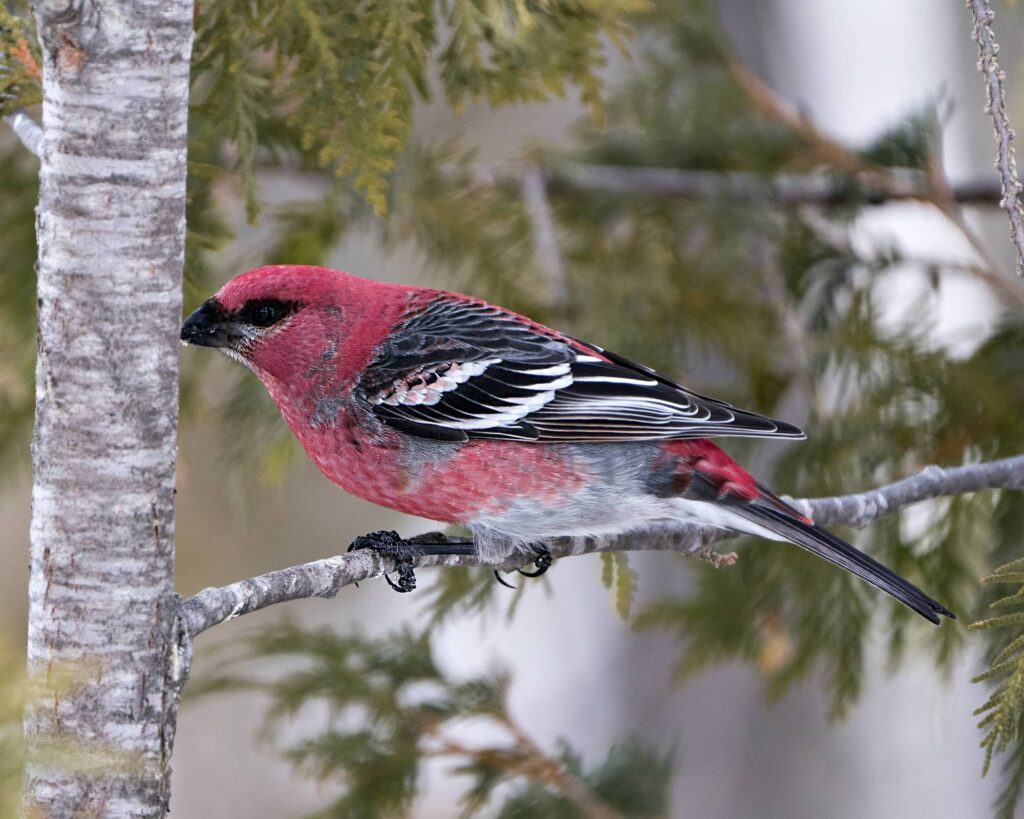
- Scientific Name: Pinicola enucleator
- Length: 9–10 inches
- Weight: 1.8–2.8 ounces
- Wingspan: 12–13 inches
Additional Information:
Pine Grosbeaks are casual visitors to Missouri, so finding one is a matter of luck. You have better chances of catching blue and rose-breasted grosbeaks since they spend the summer in the state.
Pine Grosbeaks are easy to identify, thanks to their vibrant red feathers. Their wings are gray, and their eyes are surrounded by a grayish-black area.
Northern Cardinal

- Scientific Name: Cardinalis cardinalis
- Length: 8.3–9.1 inches
- Weight: 1.5–1.7 ounces
- Wingspan: 9.8–12.2 inches
Additional Information:
Northern Cardinals are among the most common birds in North America. They’re present in most states, and they’re particularly abundant in Missouri.
You have a high chance of catching Northern Cardinals close to residential areas. They prefer to stay near populated habitats, such as backyards and parks.
You’ll easily identify these birds, thanks to their thick bills and distinctive crowns. They mostly stay in pairs, too, so your luck will be multiplied by two!
Pileated Woodpecker

- Scientific Name: Dryocopus pileatus
- Length: 16–19 inches
- Weight: 8.8–14.1 ounces
- Wingspan: 26–30 inches
Additional Information:
Pileated Woodpeckers aren’t entirely red; they only have red crowns. However, their heads seem extra vibrant compared to their black bodies, so they’re their most distinctive feature.
You can easily identify these woodpeckers because of their large bodies and long pointed bills. Remember Woody Woodpecker? Yes, he was a pileated one!
You can find Pileated Woodpeckers in forested Ozarks, where they’re permanent residents. You may also find some of them around forested habitats and near the northwest region, but they’re less common there.
Red-Bellied Woodpecker
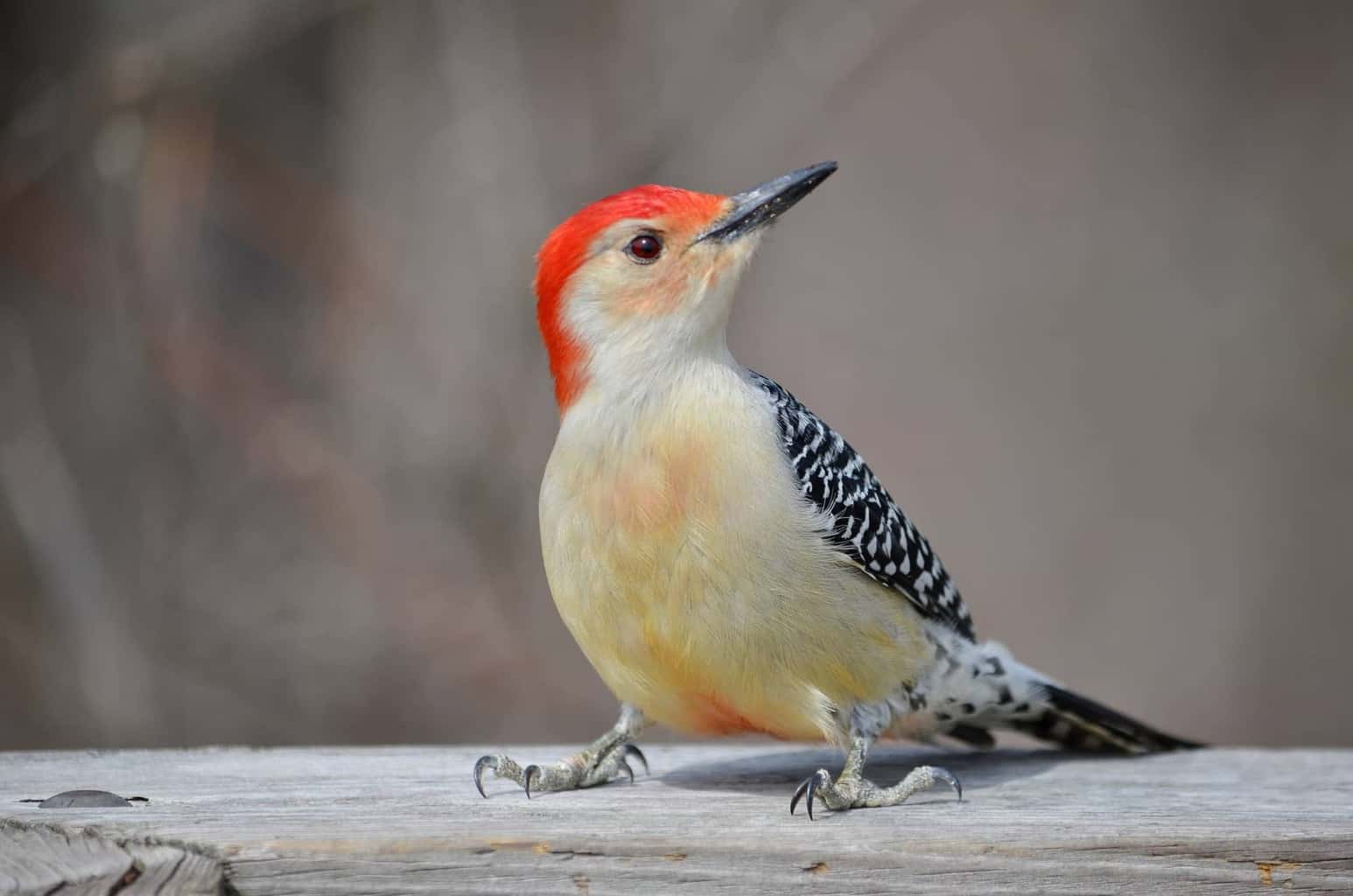
- Scientific Name: Melanerpes carolinus
- Length: 9.4 inches
- Weight: 2–3.2 ounces
- Wingspan: 13–16.5 inches
Additional Information:
Red-bellied Woodpeckers have a tricky name because their bellies aren’t red. Instead, they have red-colored head caps. Their bellies are actually white, but they gain their name because they turn instantly red when they blush.
Luckily for you, Red-bellied Woodpeckers are easy to find in Missouri. Their numbers are spread throughout the Show-Me state all year long. You’ll find them in open lands, woodlands, and backyards.
Blue Birds in Missouri
Blue Jay
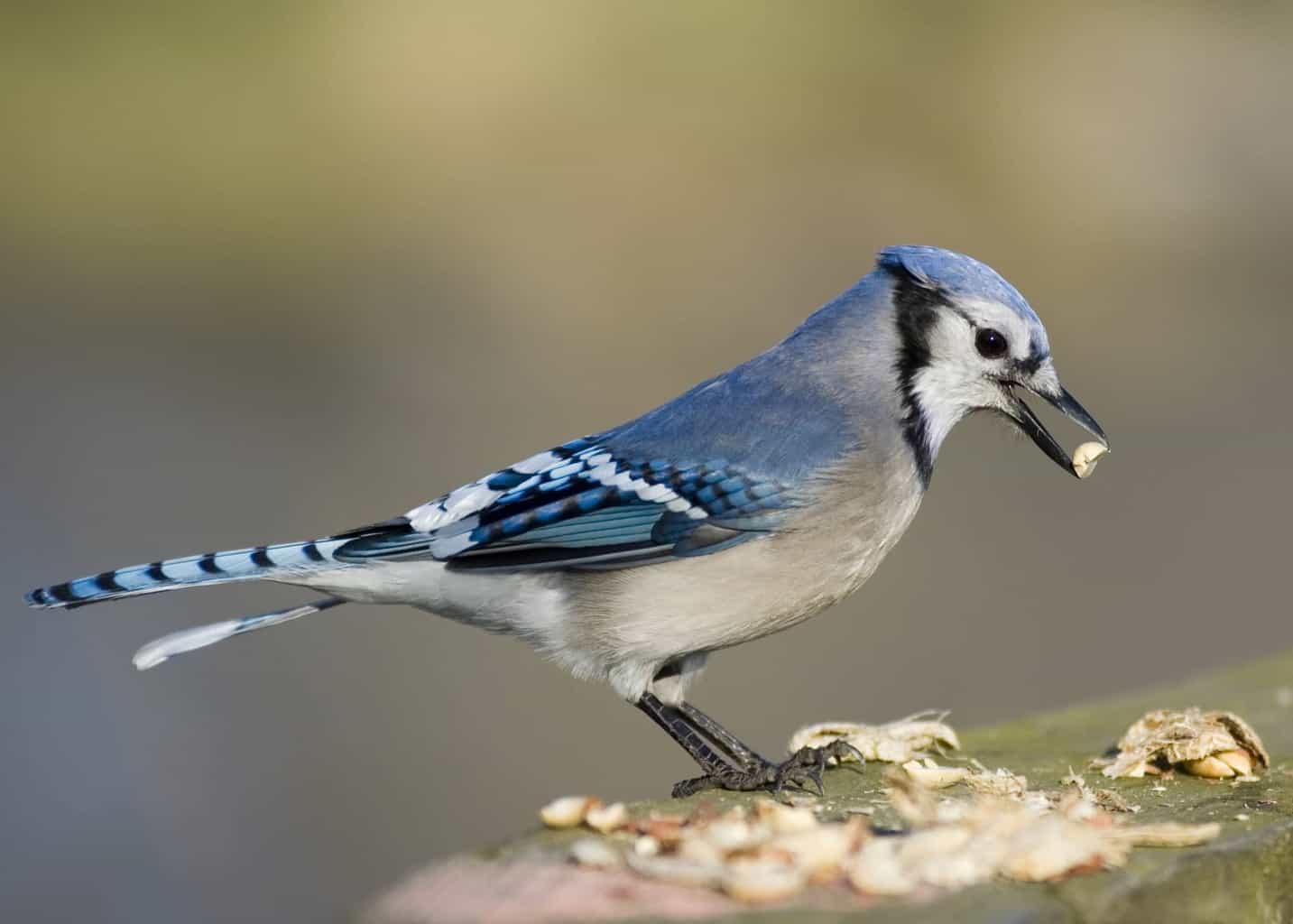
- Scientific Name: Cyanocitta cristata
- Length: 9–12 inches
- Weight: 2.5–3.5 ounces
- Wingspan: 13–17 inches
Additional Information:
Blue Jays are among the most common birds across all states. If you live in the US, you likely ran across one or two jays in your lifetime.
You can easily identify Blue Jays because of their vibrant blue feathers and pointed bills. They belong to the Corvidae family, which explains the similarities between them and their close relatives: crows. They’re much prettier, though.
Blue Grosbeak
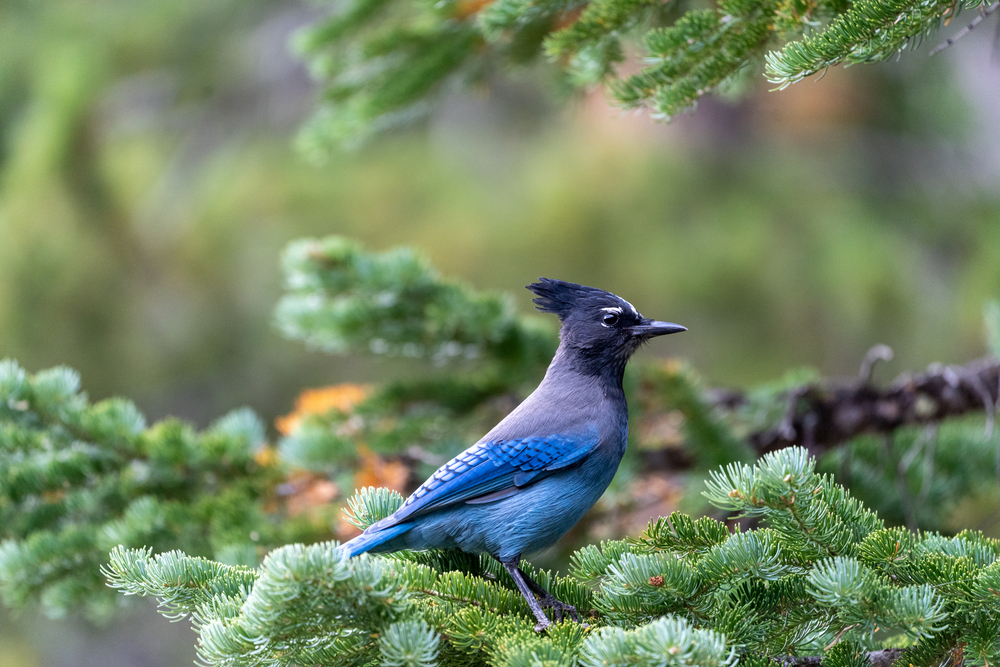
- Scientific Name: Passerina caerulea
- Length: 5.5–7.5 inches
- Weight: 0.9–1.11 ounces
- Wingspan: 10–11 inches
Additional Information:
Blue Grosbeaks are more common than pine ones, so your chances of catching one in Missouri are pretty high. They’re present in the state from May until September.
When they’re in their breeding season, the males’ bodies are completely blue. The feathers on the edges turn brown when the season ends, close to the end of the spring.
You can mistake a Blue Grosbeak for an Indigo Bunting, but grosbeaks are much smaller with smaller bills.
Common Grackle
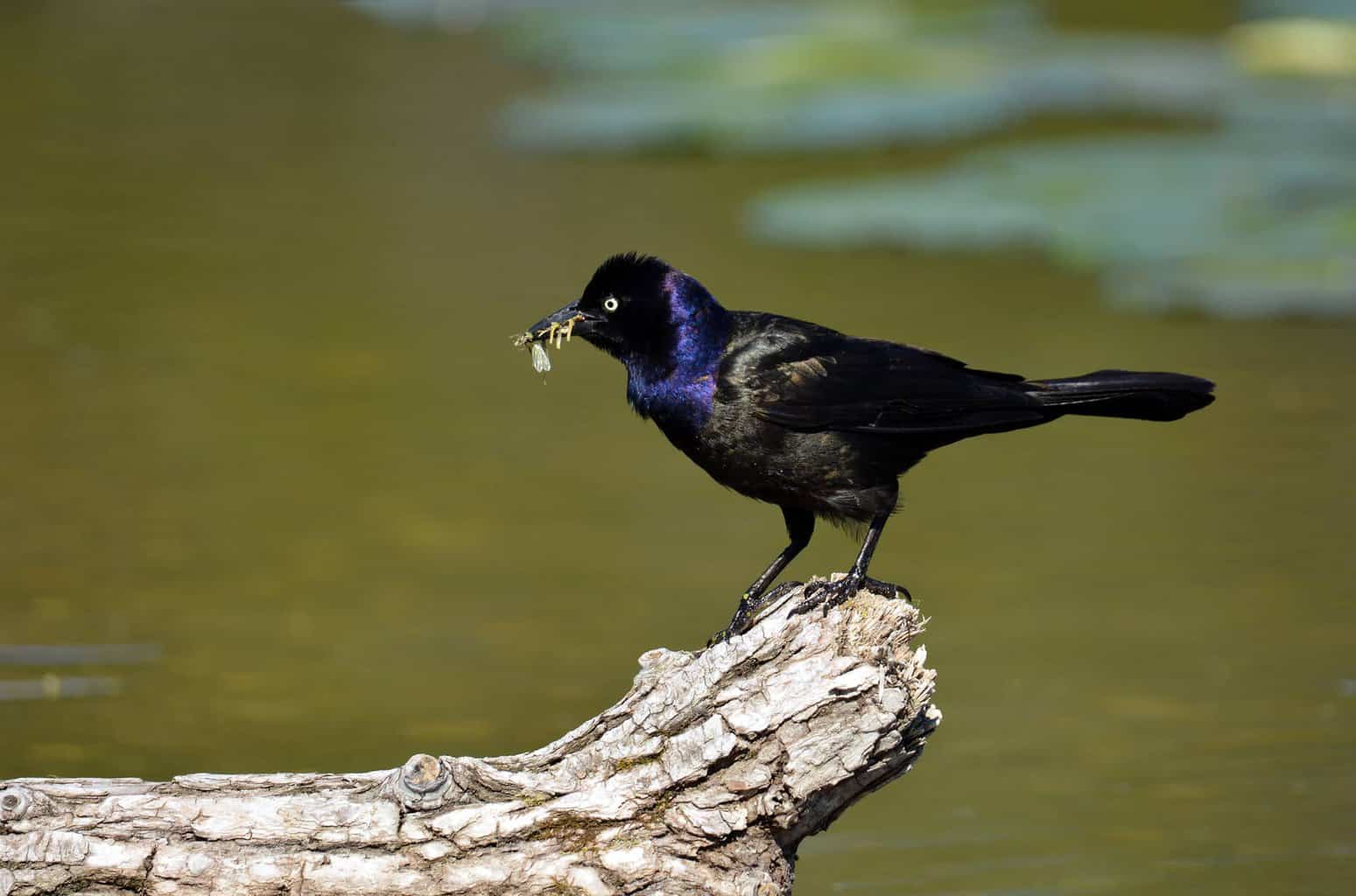
- Scientific Name: Quiscalus quiscula
- Length: 11–13 inches
- Weight: 2.6–5 ounces
- Wingspan: 14–18 inches
Additional Information:
Common Grackles aren’t bluebirds per se, but they have blue heads with the color extending down to their chests.
These birds are present in Missouri all year long, so you can catch them at any time you visit the state. Their populations are also on the rise, so your chances of catching them are high.
The Common Grackle is mostly black, but its feathers are iridescent, making it look glossy under the light and giving it a magical look.
Eastern Bluebird
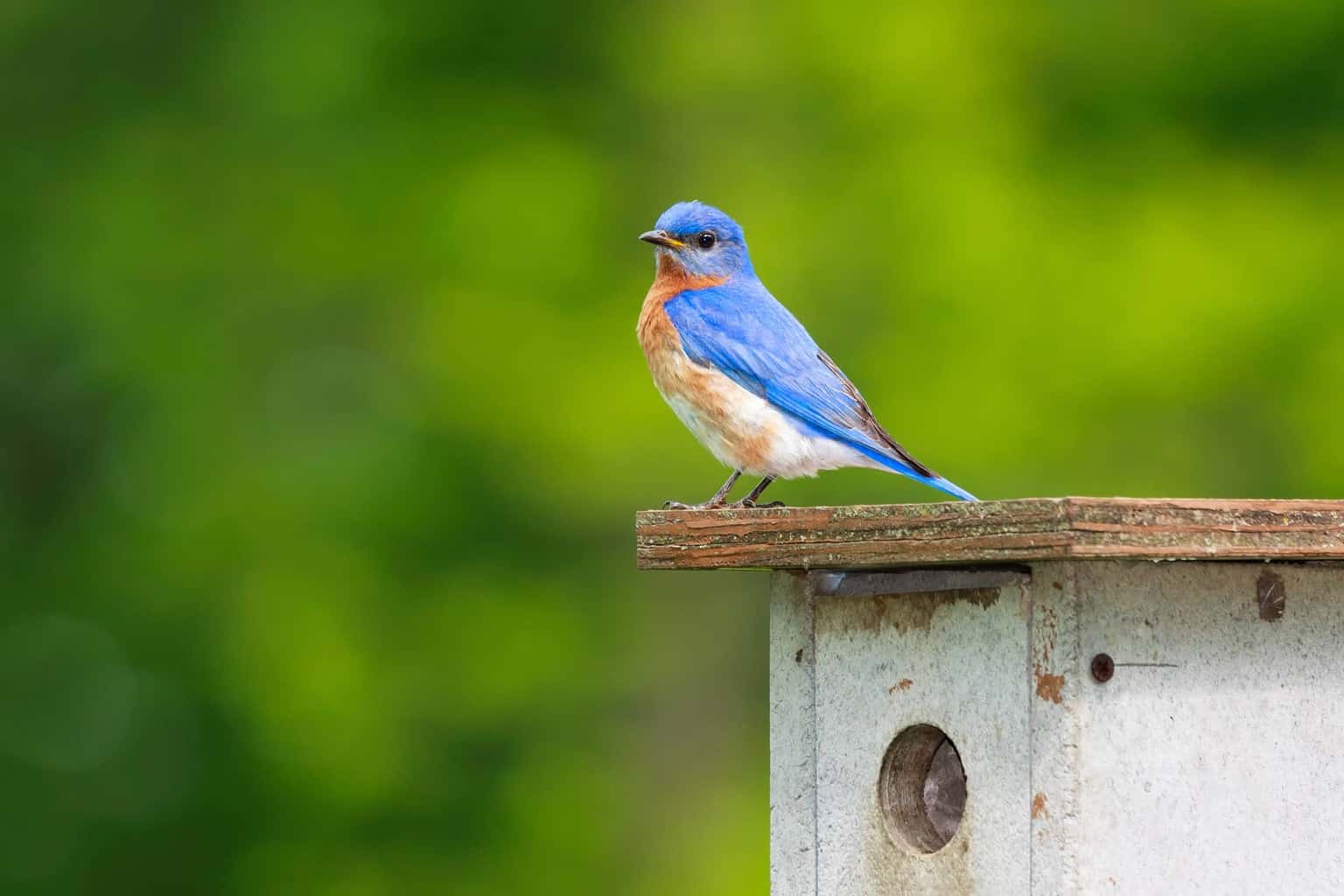
- Scientific Name: Sialia sialis
- Length: 6.3–8.3 inches
- Weight: 1–1.2 ounces
- Wingspan: 10–12.6 inches
Additional Information:
Eastern Bluebirds have blue wings and heads, with orange chests and white underbellies. They have a unique color combination, and the orange color goes around their throats, looking like a collar.
You can find these birds in a variety of places, including parks, open habitats, meadows, and golf courses.
They’re uncommon backyard feeders because they’re a bit shy, but you can lure them in with some seeds and suet.
Blue-Gray Gnatcatcher
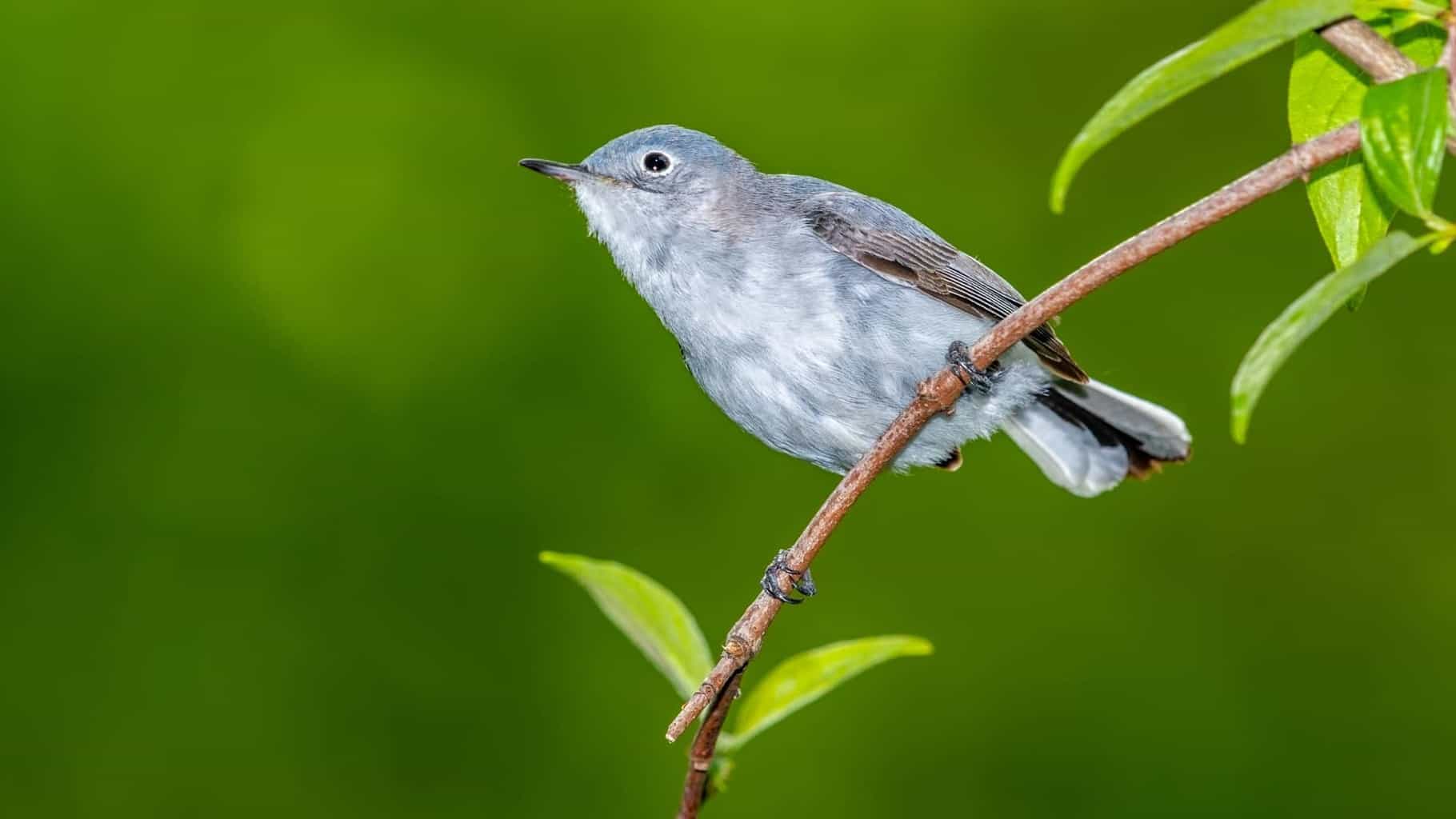
- Scientific Name: Polioptila caerulea
- Length: 4–4.3 inches
- Weight: 0.2–0.3 ounces
- Wingspan: 6.3 inches
Additional Information:
Blue-gray Gnatcatchers look funny and almost cartoon-like. They have round bodies that make them look like balls of feathers, and their males have pale blue backs and head caps.
Due to their small bodies, these birds only feel safe inside dense foliage. That’s why you’ll mostly find them in deciduous forests and near shrubbery.
If you have shrubs in your backyard, you may find a gnatcatcher hiding there.
Despite their misleading name, Blue-gray Gnatcatchers don’t feed on gnats. They feed on other insects instead, which are an integral part of their diet.
Green Birds in Missouri
Anna’s Hummingbird

- Scientific Name: Calypte anna
- Length: 3.9–4.3 inches
- Weight: 0.1–0.2 ounces
- Wingspan: 4.7 inches
Additional Information:
Hummingbirds are all small and similar in shape, but Anna’s Hummingbirds are easily distinguishable, thanks to their sparkly red heads and green wings. Their wings are iridescent – paired with their glittery heads, they give the birds a magical look.
You’ll recognize Anna’s Hummingbird a mile away. If you want your chances to get higher, look for these small birds near colorful blossoms and cultivated gardens.
They’re also frequent backyard visitors, particularly in the spring.
If you want to lure them in, lay some suet, seeds, and raisins. You’ll probably find them in your backyard feeder if you do so.
Calliope Hummingbird

- Scientific Name: Selasphorus calliope
- Length: 2.8–3.9 inches
- Weight: 0.071–0.1 ounces
- Wingspan: 4.3 inches
Additional Information:
Like Anna’s Hummingbirds, Calliope Hummingbirds are easy to identify and unique. Their males have iridescent Fuschia necks, and the females have sparkly green wings.
Calliope Hummingbirds are the smallest birds in the United States, so you may have to strain your eyes to catch one. Nevertheless, they’re pretty common in Missouri, so the stakes are high.
These small birds love perching on alders and willows; that’s where you’ll mostly find them, besides backyard feeders.
Green-Tailed Towhee
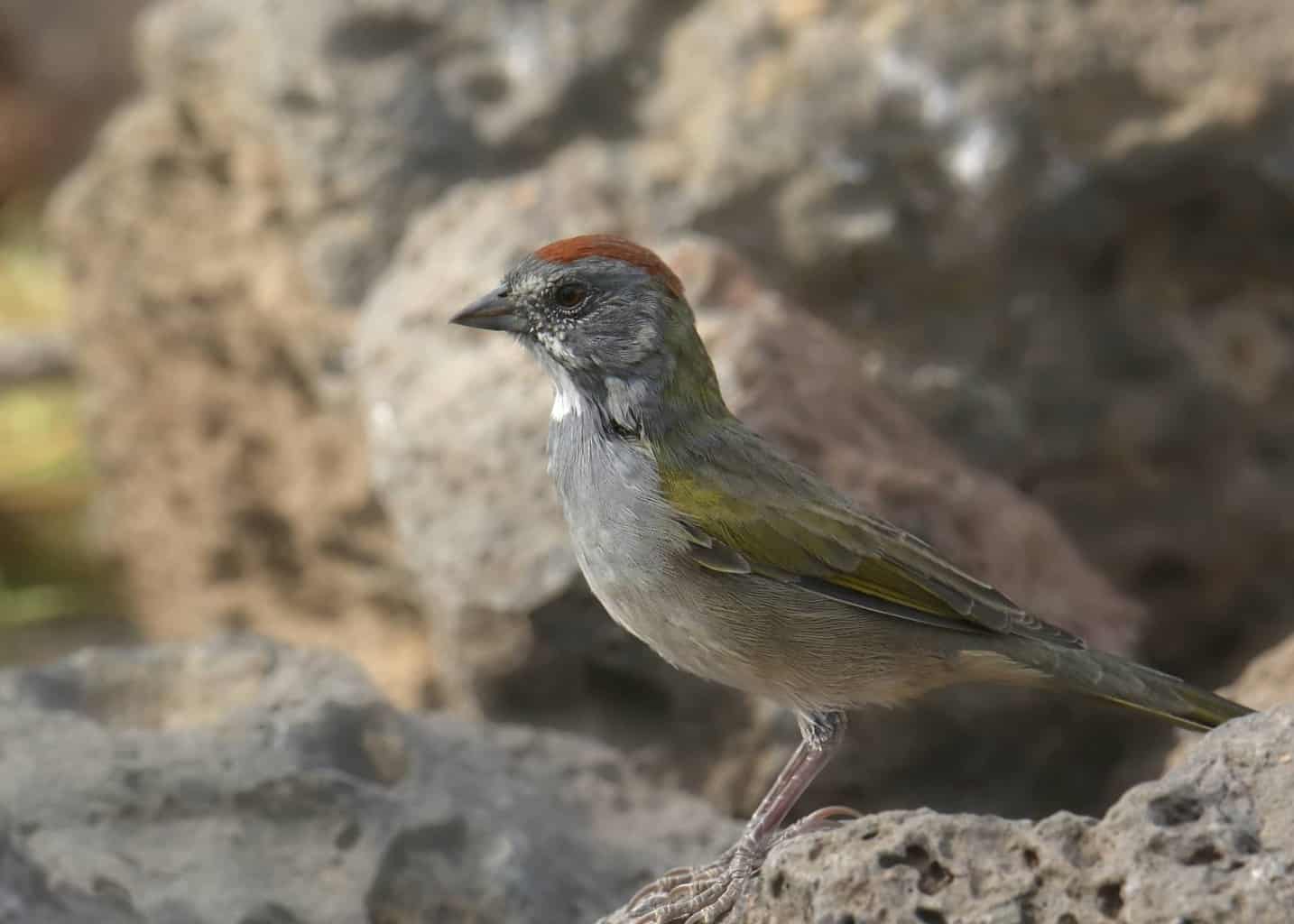
- Scientific Name: Pipilo chlorurus
- Length: 7.25 inches
- Weight: 0.8–1 ounce
- Wingspan: 0.9–1.4 ounces
Additional Information:
True to their name, Green-tailed Towhees have green tails and wings. Their head caps are dull orange, and the rest of their bodies are grayish brown. Juvenile towhees have more green in their bodies, making them easier to identify than adults.
These birds are challenging to catch because they have a secretive nature. They don’t like to make their presence known, so seeing them in open land is a slim chance.
Your best chance at catching a Green-tailed Towhee is near shrubby mountainsides in the early summer.
Green Heron
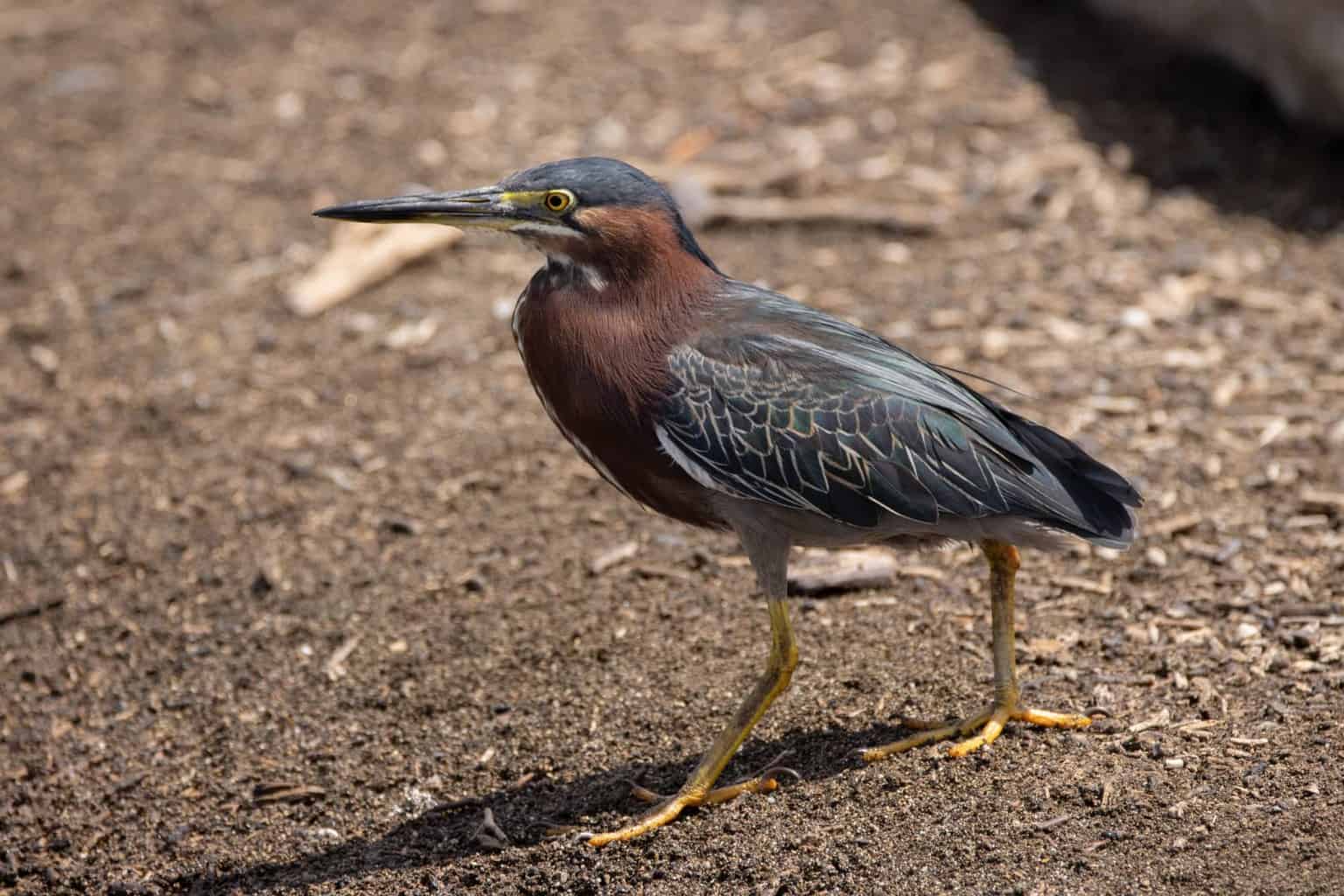
- Scientific Name: Butorides virescens
- Length: 16–18 inches
- Weight: 8–8.5 ounces
- Wingspan: 25–26.8 inches
Additional Information:
Green Herons are a bit tricky to identify because most of them aren’t green. Only the adults have green wings, and the color only appears under good lighting because the feathers are iridescent. You’ll have to look closely to catch one.
These yellow-legged birds stay in Missouri from mid-April to late October, so you have a high chance of catching them. They’re more common between May and August, and they mostly stay near rivers.
Your chances of catching them are higher near water streams and swamps.
Orange Birds in Missouri
American Robin

- Scientific Name: Turdus migratorius
- Length: 9.1–11.0 inches
- Weight: 2.5–3 ounces
- Wingspan: 12–16 inches
Additional Information:
American Robins are pretty common in the United States; there’s a high chance one of them is flying around your house as you’re reading this!
These popular birds have orange fronts and pale gray wings. They’re abundant in Missouri, particularly near the end of winter. They prefer staying close to city streets, so you’ll mostly find them in populated areas, such as parks and residential areas.
American Robins are frequent visitors to backyard feeders. If you lay some fruits and seeds, they’ll probably pay a visit.
Baltimore Oriole
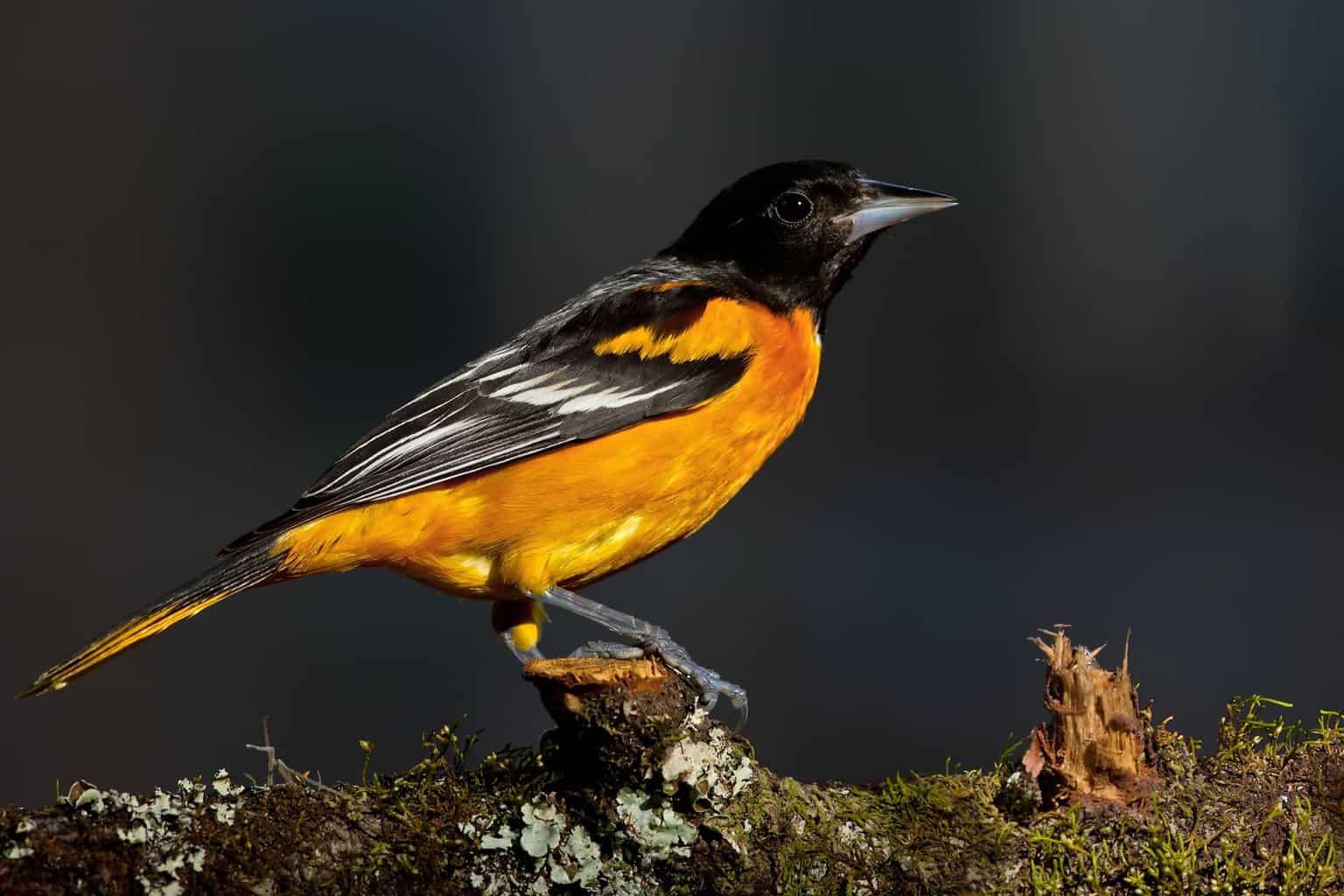
- Scientific Name: Icterus galbula
- Length: 6.6–7.5 inches
- Weight: 1–1.4 ounces
- Wingspan: 9–11.8 inches
Additional Information:
You probably heard the name Baltimore Orioles in a baseball context before. Well, we’re talking about the real birds here!
Baltimore Orioles have vibrant orange bodies with black heads and backs—at least the males do. Females, on the other hand, have a paler coloration, and they don’t have a hint of black in their bodies. They’re more on the yellow side.
These orange birds spend most of their time in deciduous forests and open woodlands. You may also find them on the edges of rivers.
Fox Sparrow

- Scientific Name: Passerella iliaca
- Length: 6–7.5 inches
- Weight: 1.1–1.2 ounces
- Wingspan: 10.4–11.5 inches
Additional Information:
Fox Sparrows have different colors according to their region. Therefore, you may catch a brown or a bronze one, but in Missouri, they’re mostly warm orange with specks of white all over their bodies.
These birds are small, but they’re easy to catch because they’re a little bigger than hummingbirds and gnatcatchers.
They mostly stay near dense vegetation and close to mountainous regions. In winter, they become frequent visitors to backyard feeders.
Varied Thrush
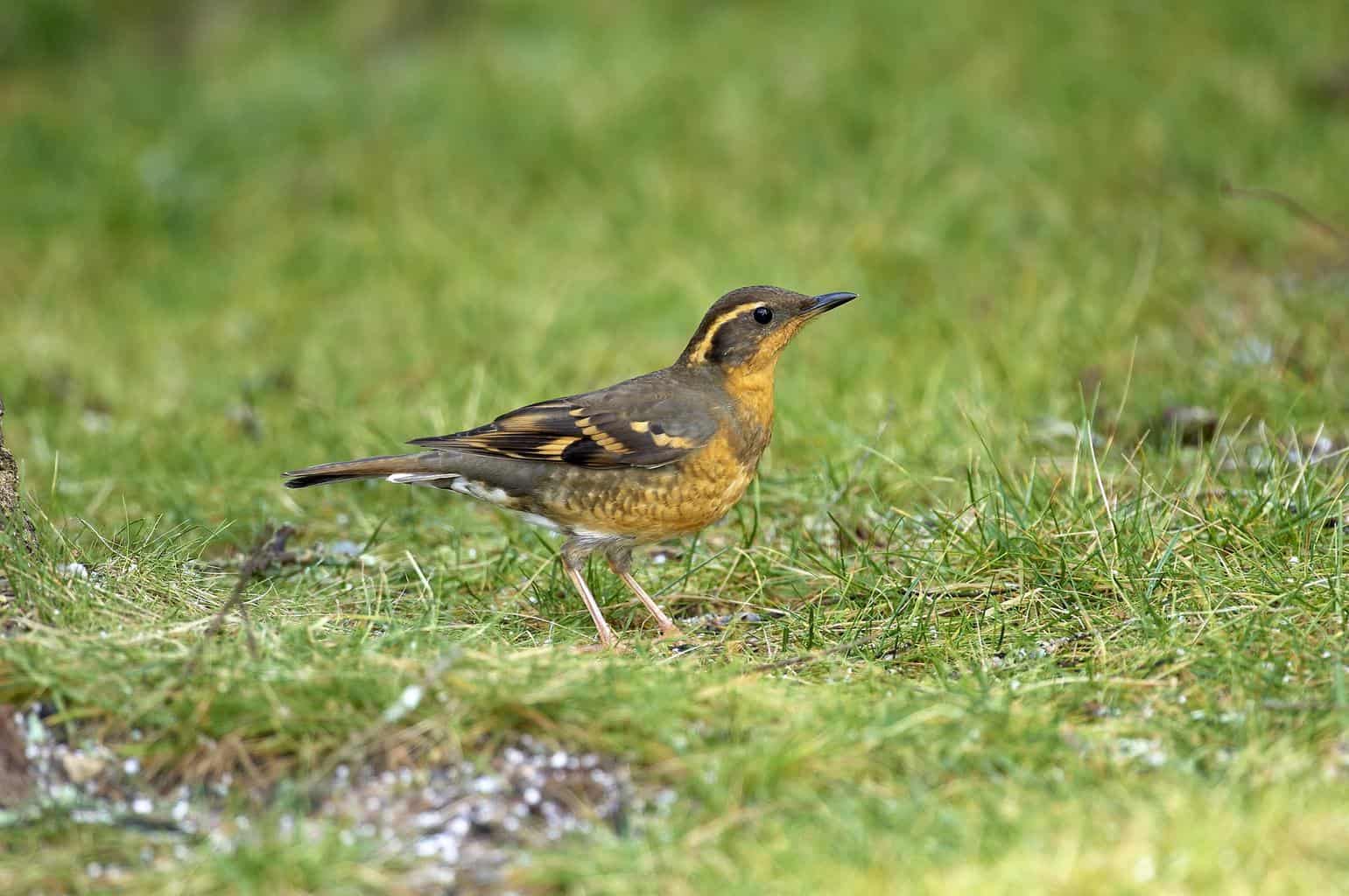
- Scientific Name: Ixoreus naevius
- Length: 7.5–10.3 inches
- Weight: 2.4–3.5 ounces
- Wingspan: 13.5–15 inches
Additional Information:
Varied Thrushes have orange round bodies with gray wings and head caps. The females have brown wings instead of gray ones, but their bellies are likewise orange. Their size is the same as that of robins, and they love to perch just like them.
These orange birds stay close to the ground often, and they spend most of their time in shrubs and thick trees.
When in their breeding season, Varied Thrush males perch on high trees and sing loudly. They’re easier to catch in this time interval.
Black-Headed Grosbeak
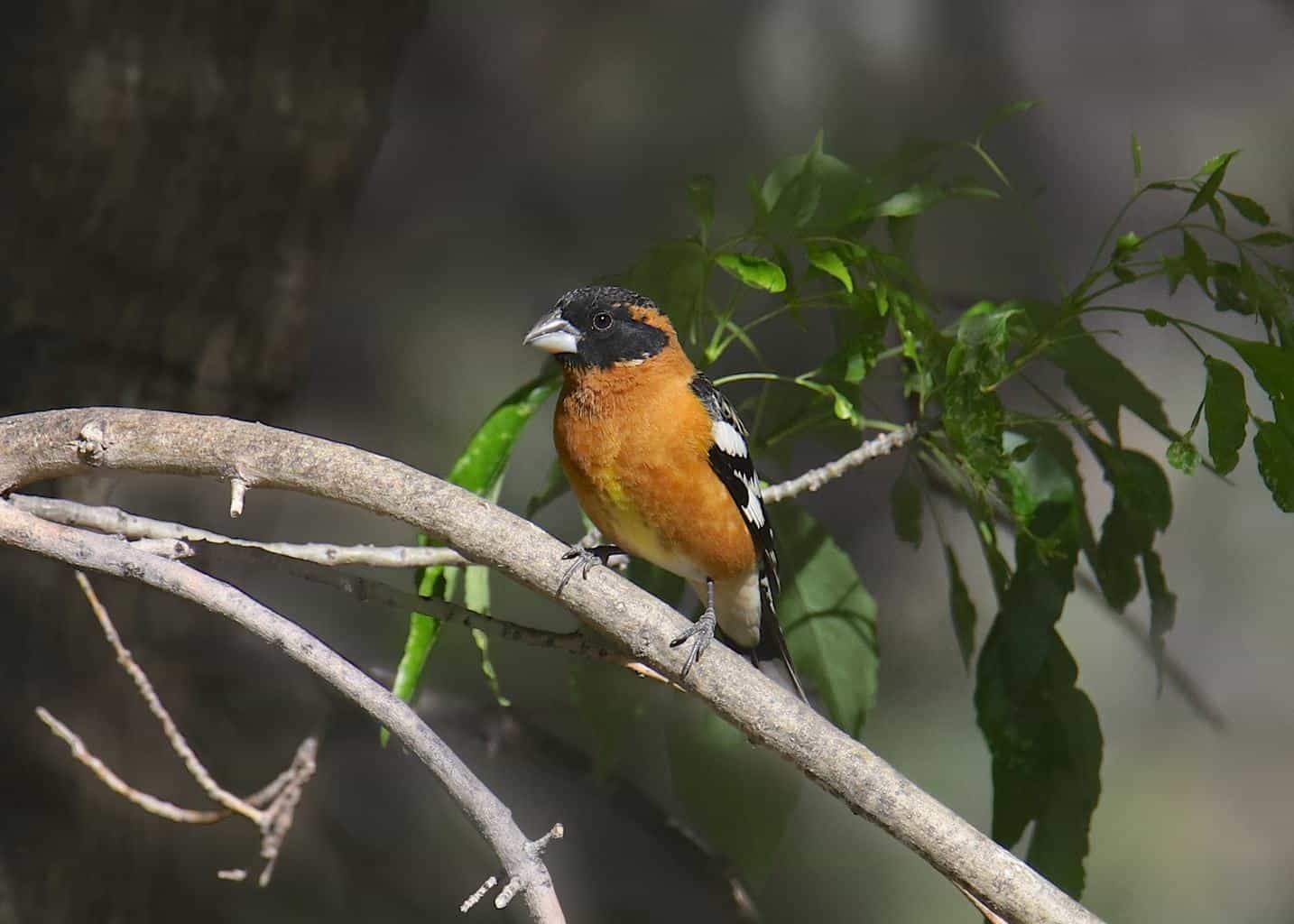
- Scientific Name: Pheucticus melanocephalus
- Length: 7–7.5 inches
- Weight: 1.1–1.7 ounces
- Wingspan: 12.6 inches
Additional Information:
Black-headed Grosbeaks look mostly black and white if you look from afar. If you look closely, you’ll see they have cinnamon orange fronts and backs, with only their wings being black and white. The females are more on the brown side, but they have similar orange plumages.
These orange birds spend most of their time in mixed woodlands and mountain forest edges. They also frequently visit gardens and backyards.
As you can see, they have diverse habitats, and they nest pretty much everywhere.
Yellow Birds in Missouri
American Goldfinch

- Scientific Name: Spinus tristis
- Length: 4.3–5.5 inches
- Weight: 0.39–0.71 ounces
- Wingspan: 7.5–8.7 inches
Additional Information:
American Goldfinches have bright yellow bodies; you’ll catch them a mile away. Their foreheads are black, creating a strong contrast against their bodies. The female finches are a bit paler, but they still have yellow bodies.
These birds are the only goldfinches that nest and live in Missouri. They love visiting backyard feeders, and they commonly stay near forested lands and clearings.
Despite their small size, American Goldfinches are known for their migratory behavior. Their range goes from mid-Alberta all the way to North Carolina.
They also pass by Southern Canada and Mexico around wintertime.
Yellow-Breasted Chat
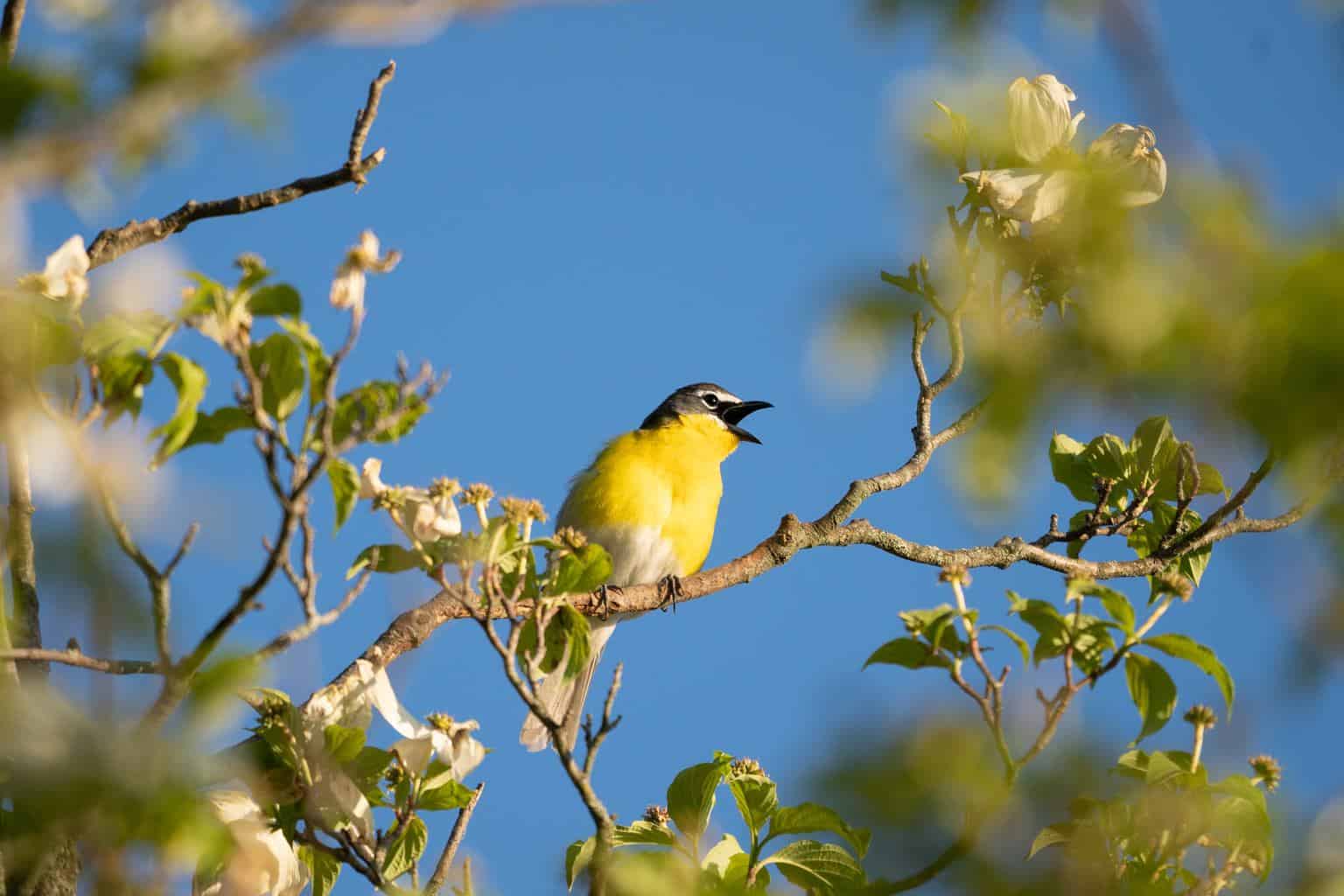
- Scientific Name: Icteria virens
- Length: 7–7.2 inches
- Weight: 0.9–1.1 ounces
- Wingspan: 9.8–10 inches
Additional Information:
The Yellow-breasted Chat belongs to the New World Warblers, but it looks odd among them because it’s much larger, and more resembles a mockingbird.
The bird’s placement in the family is still a matter of controversy, but at least we know it’s yellow! It has grey wings and head caps, and its front is yellow.
Yellow-breasted Chats are common in southern Missouri summertime. You can also see some of them in northwestern Missouri, but the chances are slim. They prefer staying near dense foliage and regrowing areas.
American Redstart
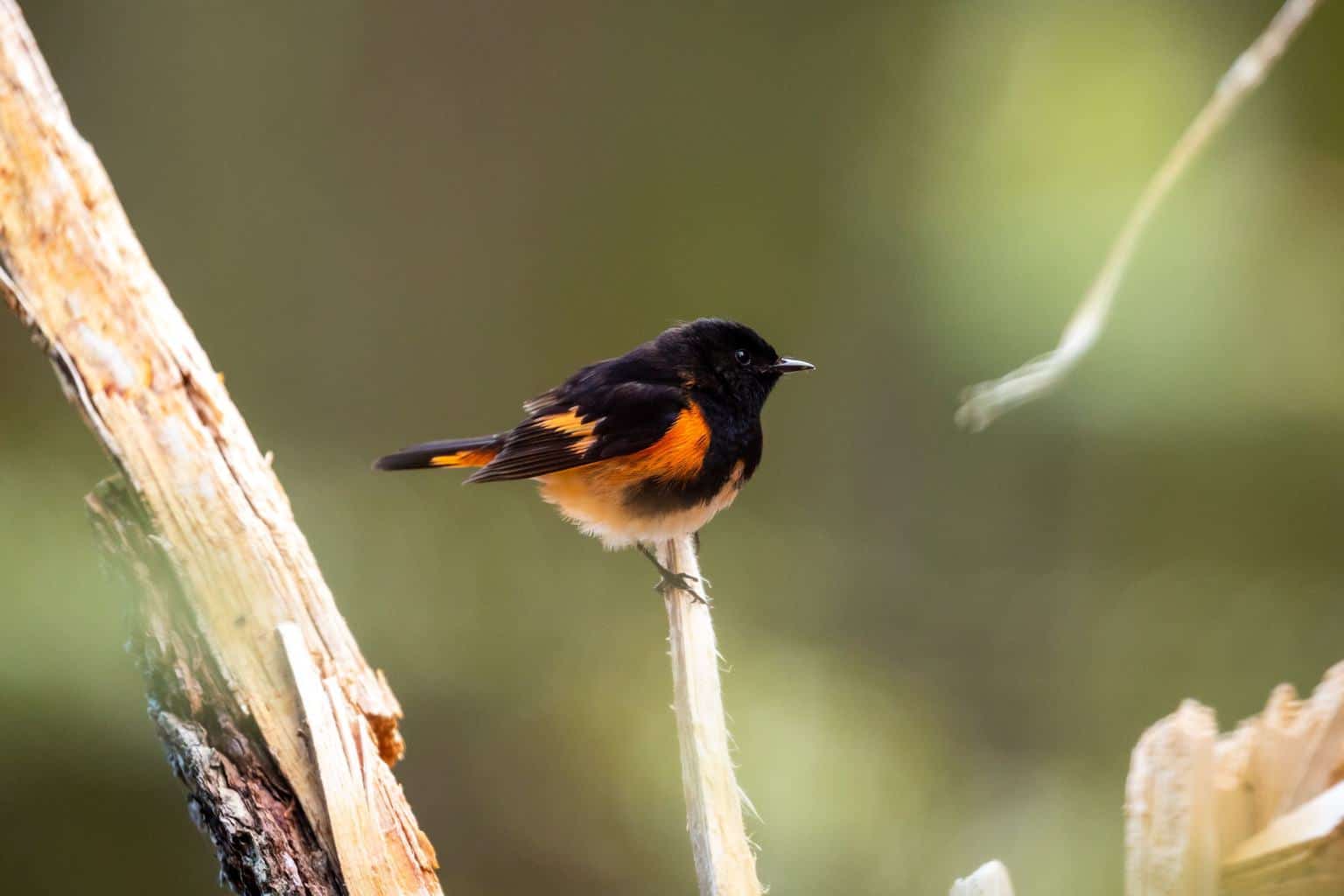
- Scientific Name: Setophaga ruticilla
- Length: 4.5–5.1 inches
- Weight: 0.2–0.4 ounces
- Wingspan: 6.4–7.5 inches
Additional Information:
American Redstarts, too, belong to the New World Warbler family. Unlike Yellow-breasted Chats, Redstarts have all the traits of the family, including the unusually small size.
These yellow birds have yellow fronts—males have black wings and backs, while females are more on the gray side. The yellow on the males also leans towards orange a bit.
You can see American Redstarts in Missouri starting from late March until early September. They mostly stay near open woodlands and forests, and they’re pretty active.
You’ll rarely see one perching on a tree. Instead, it’ll be flying around, spreading its tail, showing the yellow patch underneath.
Hooded Warbler
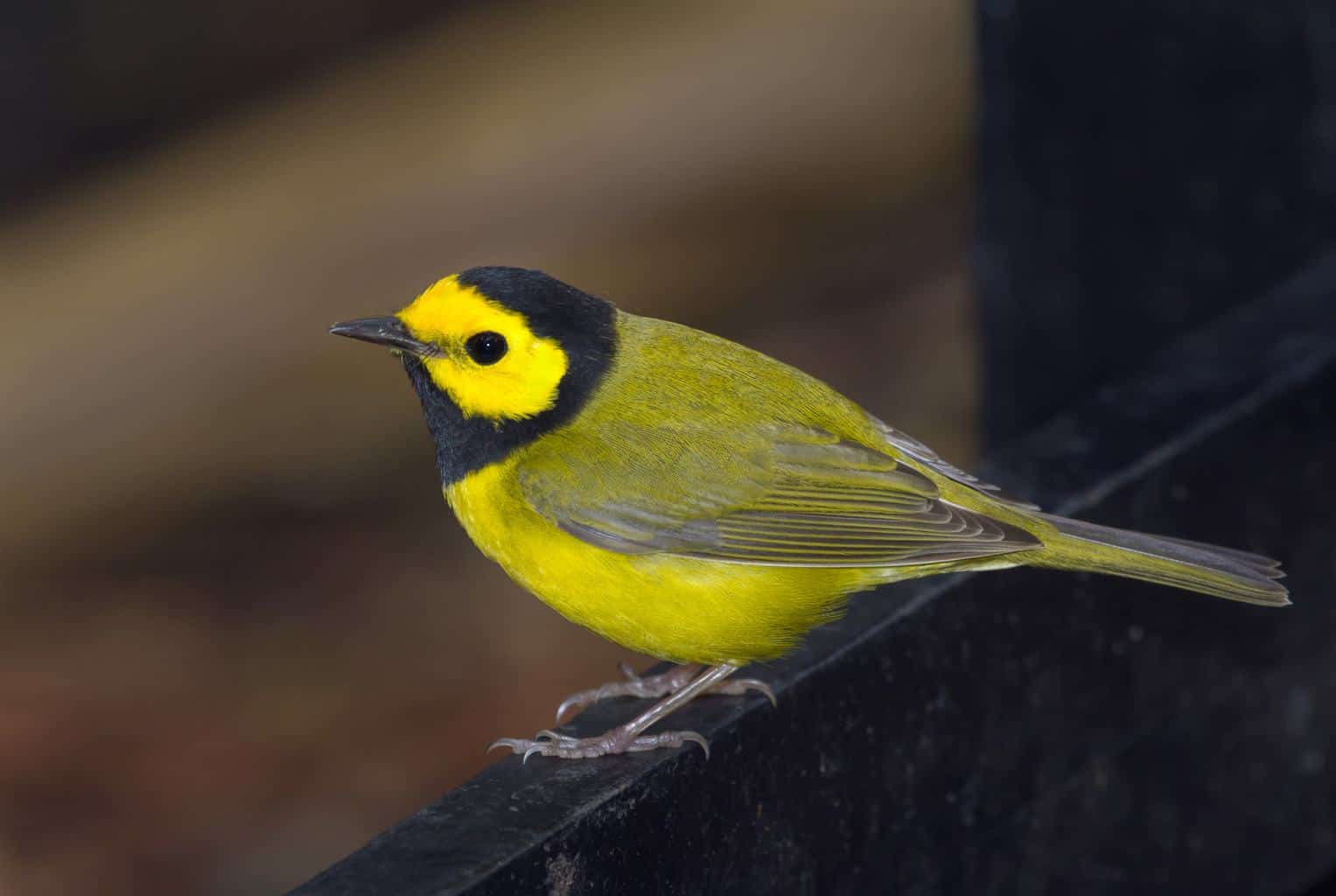
- Scientific Name: Setophaga citrina
- Length: 5–5.2 inches
- Weight: 0.2–0.5 ounces
- Wingspan: 6.9–7.1 inches
Additional Information:
The Hooded Warbler is one of the most distinctive New World Warblers, thanks to its hood-like cap around its head. The bird looks like it’s wearing a black hood, which makes a bright contrast against the yellow area around the eyes,
The bird’s body is mostly yellow, with a yellowish-gray tail and wings.
Hooded Warblers mostly stay hidden in thick vegetation, only getting out to catch the occasional insect. If you’re lucky, you can catch them in deciduous forests.
Other Birds To Watch For in Missouri
House Sparrow

- Scientific Name: Passer domesticus
- Length: 6–6.7 inches
- Weight: 0.9–1.1 ounces
- Wingspan: 7.6–9.8 inches
Additional Information:
House Sparrows have relatively small bodies. Their bellies are gray, while their wings are brown with specks of black. Their head caps are also brown, and their eyes are surrounded by a circle of black.
The females have paler coloration than males, like the way it is with most birds.
Unfortunately, House Sparrows aren’t protected by the Wildlife Code in Missouri, so they’re frequently targeted by pellet guns. Their population isn’t on the rise, but your chances of catching them are pretty good.
These small birds mostly stay around the countryside and the city streets.
Purple Finch

- Scientific Name: Haemorhous purpureus
- Length: 4.8–6.3 inches
- Weight: 0.5–1.1 ounces
- Wingspan: 8.8–10.2 inches
Additional Information:
Purple Finches are among the most distinctive birds in Missouri. The males have a raspberry-red plumage that makes them stand out from the crowd.
Their heads are pink-red, with the color getting lighter as it extends down to their breasts. Meanwhile, their wings are mostly black, mixing with the same shade on their heads.
The females don’t have a hint of raspberry red on their bodies. Instead, their plumage is all brown and white.
In the winter, Purple Finches are known to visit backyards and stay around old fields. At other times, they’re in coniferous forests.
European Starling
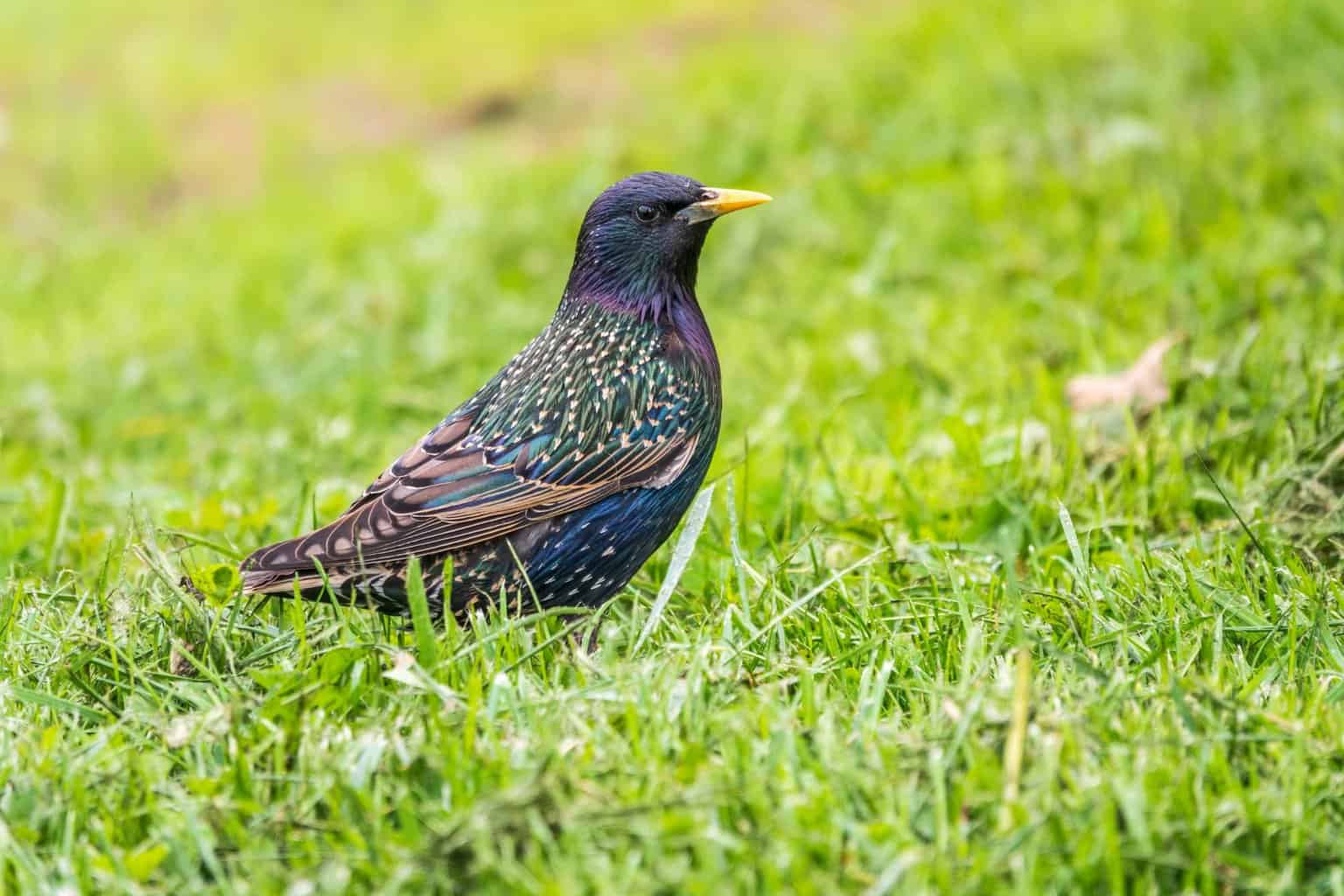
- Scientific Name: Sturnus vulgaris
- Length: 8–9 inches
- Weight: 2–3.5 ounces
- Wingspan: 12–16 inches
Additional Information:
The European Starling, or Common Starling as most people call it, is one of the most beautiful birds you can see in Missouri. Their iridescent bodies are a unique blend of purple and dark blue.
Under the light, European Starlings look absolutely magical because their feathers get bright and shiny.
These birds are commonly found in parks, fields, and city streets. When looking for them, check the ground.
They’re known to hop around in a zig-zag motion, digging their bills into the soil in search of insects to feed on.
Rock Pigeon
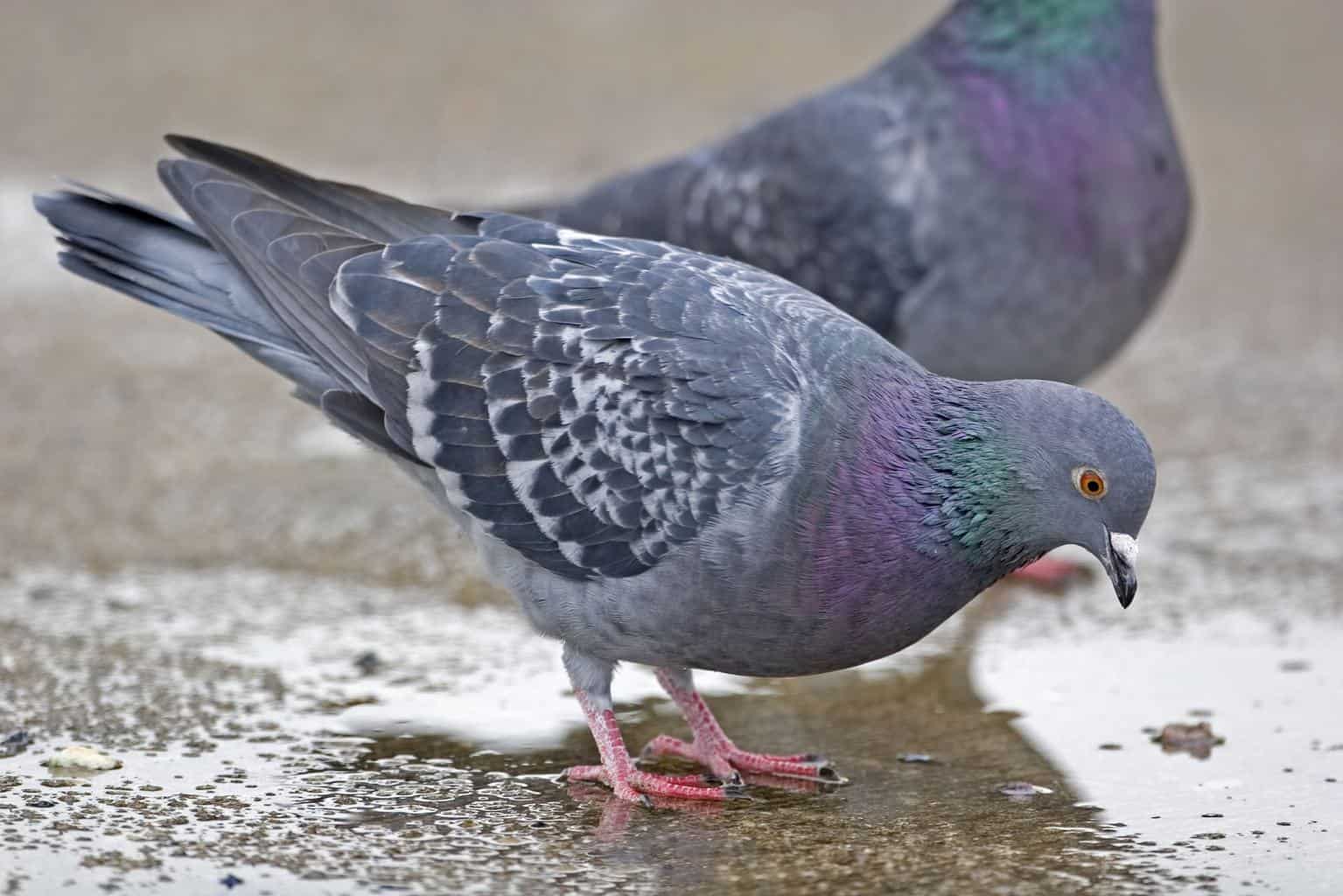
- Scientific Name: Columba livia
- Length: 11.9–14.2 inches
- Weight: 9.4–13.4 ounces
- Wingspan: 19.8–26.5 inches
Additional Information:
Rock Pigeons are pretty common throughout the states. They’re easy to identify because they’re all bluish-gray, and they have a band of iridescent feathers on their throats.
Under good lighting, their throats look either green or purple. Plus, their wings have two black bands. Bear in mind that they have a lot of variations depending on the region, though.
Rock Pigeons mostly stay around city streets and populated areas. You’ll likely run into them in parks, fields, and urban areas.
Black-Capped Chickadee
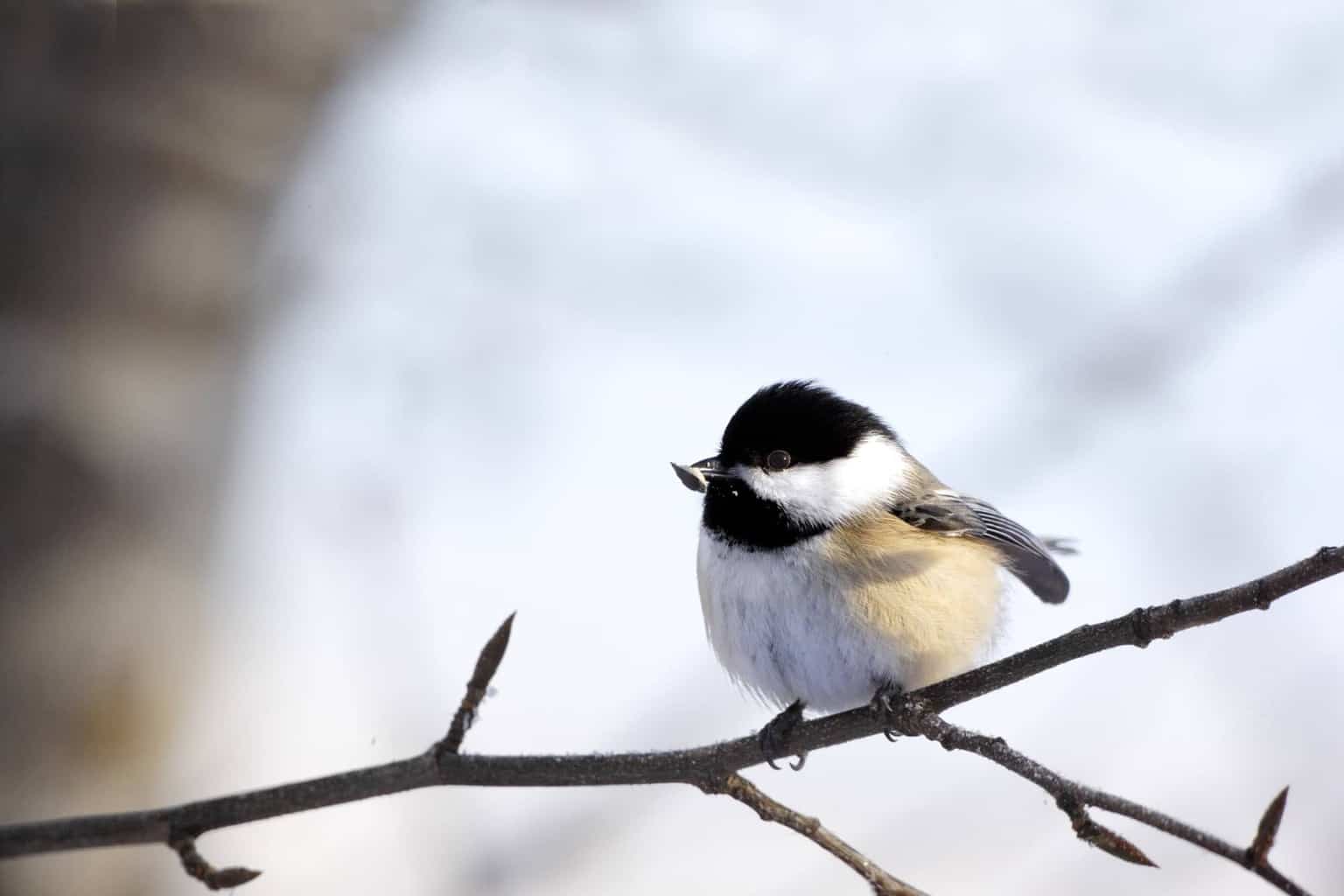
- Scientific Name: Poecile atricapillus
- Length: 4.7–5.9 inches
- Weight: 0.3–0.5 ounces
- Wingspan: 6.3–8.3 inches
Additional Information:
Black-capped Chickadees have round bodies, making them look like balls of feathers. They’re similar to Blue-gray Gnatcatchers in the sense that they look funny and cartoon-like. However, their bodies are all black and white without a hint of color.
Chickadees don’t visit backyard feeders. If you want to see them, you’ll have to visit their habitats, which are mostly near thick shrubbery and woodlands. They also visit parks frequently.
Conclusion
As you can see, there’s a variety of birds of all colors in Missouri. If you’re in the mood for some red birds, look out for a Northern Cardinal. Meanwhile, Green-tailed Towhees and Anna’s Hummingbirds are there for green lovers.
Strolling around the city streets, you’ll definitely encounter one or two birds on our list. Remember to strain your ears for hummingbird calls, especially around the breeding season!

